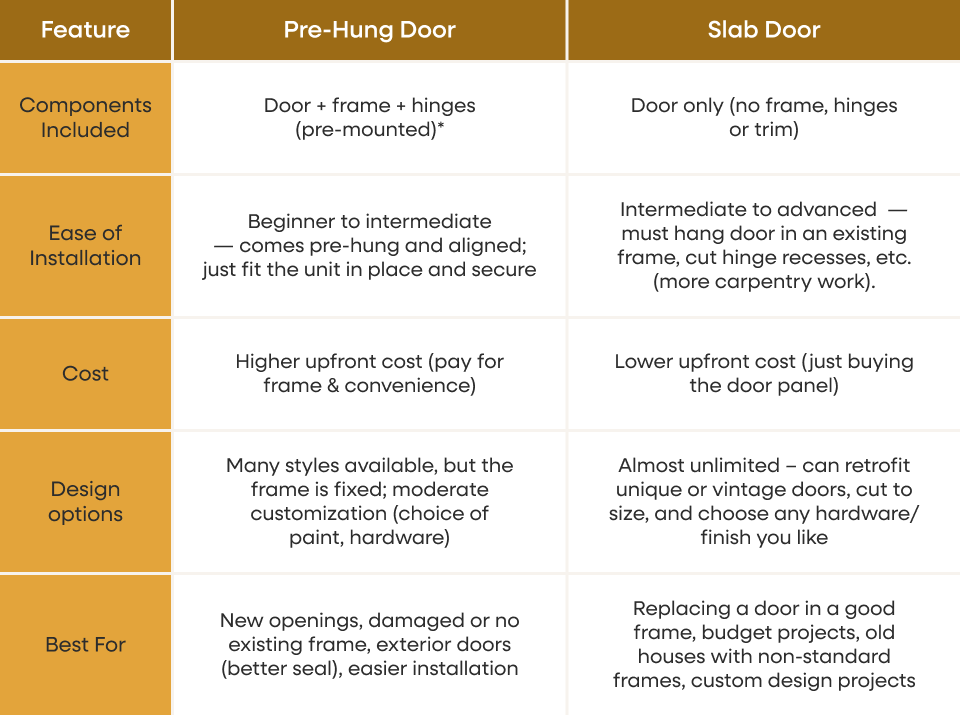Whether you’re tackling a full renovation, replacing a single damaged door or building from scratch, choosing the right type of door can save you time, money and frustration down the road.
Two of the most common formats you’ll come across are pre-hung doors and slab doors. While they might look similar once installed, they differ in construction, installation needs and ideal use cases. Knowing the difference can help you make the right call for your space and avoid common headaches, especially when upgrading older frames or planning a new layout.
At 1st Choice Door & Millwork, we supply both slab and pre-hung interior doors, and help contractors, builders and homeowners throughout Central Florida choose the option that fits their project best. If you’re unsure where to start, we’re breaking down exactly what you need to know, starting with the basics.
What Is a Pre-Hung Door?
A pre-hung door is a complete door unit that comes ready to install. Unlike a slab door, which is just the door panel, pre-hung doors include the door itself, a three-sided frame (also called a jamb) and pre-attached hinges. Most also come with pre-cut holes for the doorknob and latch, and some even include trim or weatherstripping depending on the application.
Because everything is aligned and pre-assembled at the factory, pre-hung doors are designed to fit directly into a rough opening with minimal extra work. This makes them a go-to for new construction, renovations involving full frame replacement or any project where the existing frame is damaged, warped or out of square.
This format is especially common for entryways and exterior doors, where a tight seal and square frame are essential for energy efficiency, weather resistance and security. But many interior doors also come pre-hung, especially in cases where speed and precision matter.
What Is a Slab Door?
A slab door is exactly what it sounds like: just the door panel itself, with no hinges, frame or hardware attached. Slab doors offer a blank canvas, both literally and figuratively, and give you more flexibility to match or retrofit the door to your existing setup.
Since slab doors don’t include a frame, they’re ideal for replacing doors in rooms where the frame is still in good condition. Whether you’re swapping out an outdated style or upgrading from hollow core to solid, a slab door lets you reuse the existing jamb and hinges, assuming everything is still square and functional.
Slab doors can be made from solid wood, MDF, hardboard or other engineered materials, and they’re available in a wide variety of panel designs, styles and finish options. Because they’re sold as just the panel, slab doors are typically lighter, easier to store and more cost-effective upfront as long as you’re comfortable doing a bit more work on the install side.
Slab doors are especially popular for interior remodeling projects, where the goal is to refresh or modernize a space without rebuilding every opening from scratch. They do require more precision to hang correctly, but for experienced installers or budget-conscious upgrades, they can be the perfect fit.

What are the Differences Between a Pre-Hung and Slab Door?
While both options serve the same purpose, pre-hung and slab doors differ significantly in cost, installation and convenience. Understanding these differences can help you avoid unexpected expenses or DIY headaches down the line.
Installation Differences
The biggest difference between pre-hung and slab doors is what’s already included, and how much work is required to get it properly installed.
Pre-hung doors come ready to install with the frame, hinges and door all aligned and pre-assembled. All you need to do is insert the entire unit into a rough opening, shim it to ensure it’s level and plumb (vertically straight), and secure it with screws or nails. Because everything is already square, this makes installation faster and more forgiving, even for first-timers or homeowners doing a renovation.
Slab doors, by contrast, are just the door panel. Installing one involves more carpentry: aligning it within an existing frame, cutting hinge mortises (shallow, chiseled-out pockets in the door edge where the hinges sit flush), drilling hardware holes and ensuring the door hangs and swings correctly. If your frame isn’t perfectly square, which many in older homes aren’t, that adds complexity.
Cost Comparison
Upfront Cost
Slab doors are generally the more affordable option to purchase. Pre-hung doors, which include both the door and the frame, will typically cost more than a slab door for a similar look and build.
Hardware & Materials
That price difference reflects more than just the frame: pre-hung doors come pre-assembled with hinges, the jamb and often pre-cut holes for the handle and latch. Slab doors, on the other hand, require separate purchases for hinges, screws, the frame and hardware prep, which can add to the total cost, even if the initial sticker price looks lower.
Installation Labor
If you’re hiring a contractor, labor costs may swing the price comparison in the other direction. While slab doors are cheaper upfront, they demand more time to fit properly into an existing frame, which can lead to higher labor fees.
Pre-hung doors, by contrast, are quicker to install since they come pre-mounted in their frame. The unit simply needs to be leveled, shimmed and secured, making installation faster and more cost-effective if you’re paying by the hour.
Request an Interior Door Quote
When to Choose a Pre-Hung Door
Pre-hung doors are a smart choice when you need a complete, ready-to-install solution. Because they come with the frame and hinges already attached, they’re ideal in situations where speed, precision or structural integrity matters most.
1. New Frames or Construction
If you’re building a home from scratch or adding a door to a space that doesn’t currently have one, a pre-hung door ensures a clean, square installation from the start. Since the frame is included and factory-aligned, it eliminates guesswork and provides a perfect fit in newly framed openings.
2. Damaged or Outdated Frames
Is your current door frame warped, rotted or visibly out of square? Trying to fit a slab into a compromised frame can lead to long-term performance issues. In these cases, it’s usually better to rip out the old frame and install a new pre-hung unit. This gives you a fresh, plumb and sealed setup that improves both function and appearance.
3. Exterior Doors
For exterior applications, pre-hung doors are typically the recommended choice. They often come with integrated weatherstripping, thresholds and tight-sealing jambs, which are critical for keeping out drafts, water and pests. Installing just a slab in an existing exterior frame can leave gaps or weak spots unless the frame is in perfect condition.
4. Convenience and Speed
If you’re looking for the easiest and most time-saving installation option, especially as a DIYer or someone hiring a contractor, a pre-hung door is the clear winner. With the hinges, alignment and spacing already handled, you can focus on securing the unit into place without the fine-tuning required for a slab install.
When to Choose a Slab Door
Slab doors offer flexibility and cost savings when your existing frame is still in good shape. Whether you’re refreshing outdated styles or working with a custom opening, slab doors let you reuse what you already have while giving you more creative control.
1. Replacing an Existing Door
If your door frame, casing and threshold are in solid condition, a slab door is often the most cost-effective solution. It allows you to swap out just the door leaf while keeping the existing frame and hardware. This is especially ideal for interior doors of the same size, where you can simply align with the current hinge and knob placements; no need to tear into the wall or remove trim.
2. Budget-Conscious Projects
For homeowners watching their renovation costs, slab doors offer upfront savings. You’re only paying for the door panel, not the full frame or pre-installed hardware. Just keep in mind that while slabs are cheaper to buy, they may require more installation time and skill, which could add labor costs if you’re hiring a pro. Still, for experienced DIYers or contractors, slab doors are an affordable way to update a home without starting from scratch.
3. Custom or Unusual Door Sizes
Got a non-standard doorway or a design vision that doesn’t fit the box? Slab doors are your friend. They can be trimmed, shaped or modified to fit unusual openings, or even transformed into reclaimed or barn-style statement pieces. Unlike pre-hung doors, which come in set dimensions with fixed frames, slabs provide the freedom to customize.
4. Interior Design Flexibility
Want to hand-pick your hinges, handles or stain colors? Slab doors give you a blank canvas. They’re a great option if you’re mixing styles across a home or have a specific hardware or trim aesthetic in mind. Whether you’re going modern, traditional or somewhere in between, slabs let you tailor the details to match your décor.

*Knock/lock hardware usually sold separately
Still Not Sure Which Door You Need? Let’s Talk
In the end, there’s no one-size-fits-all answer. The choice between a pre-hung vs. slab door depends on your specific needs, budget and skill level. Pre-hung doors offer convenience and ease, making them great for quick installations, new frames or exterior upgrades where a tight seal is important. Slab doors provide flexibility and savings, ideal for cosmetic door replacements or creative projects where you have a good frame in place.
Still unsure? 1st Choice Door & Millwork is here to help! We supply both pre-hung and slab doors and can assist with measuring, selecting the right style and installing your new door. Contact our team to get started.

